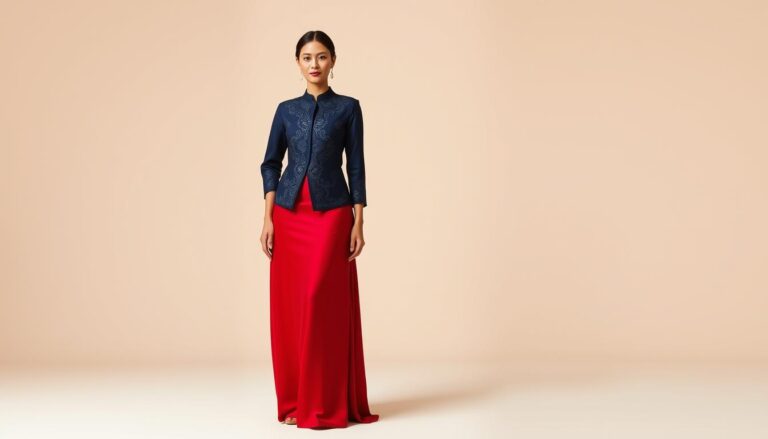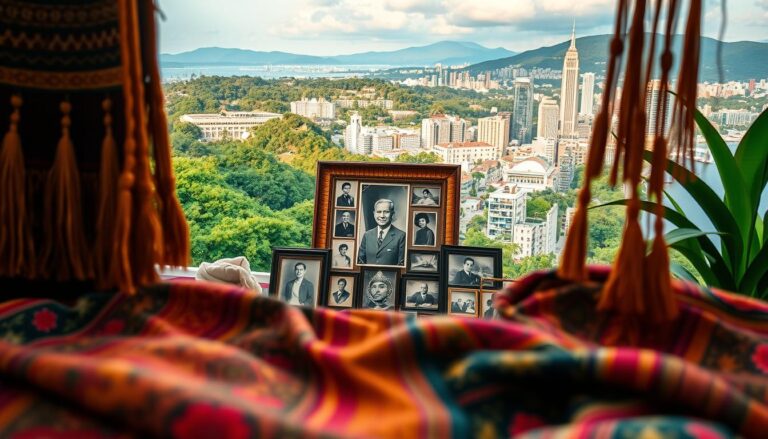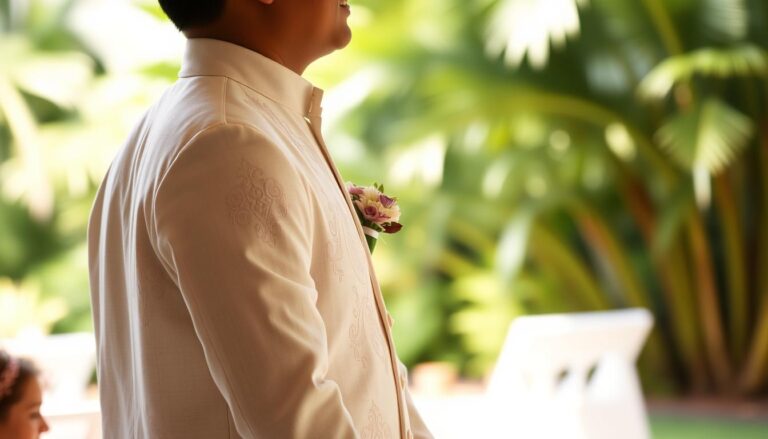Celebrity-Inspired Modern Ternos & Filipiniana Fashion
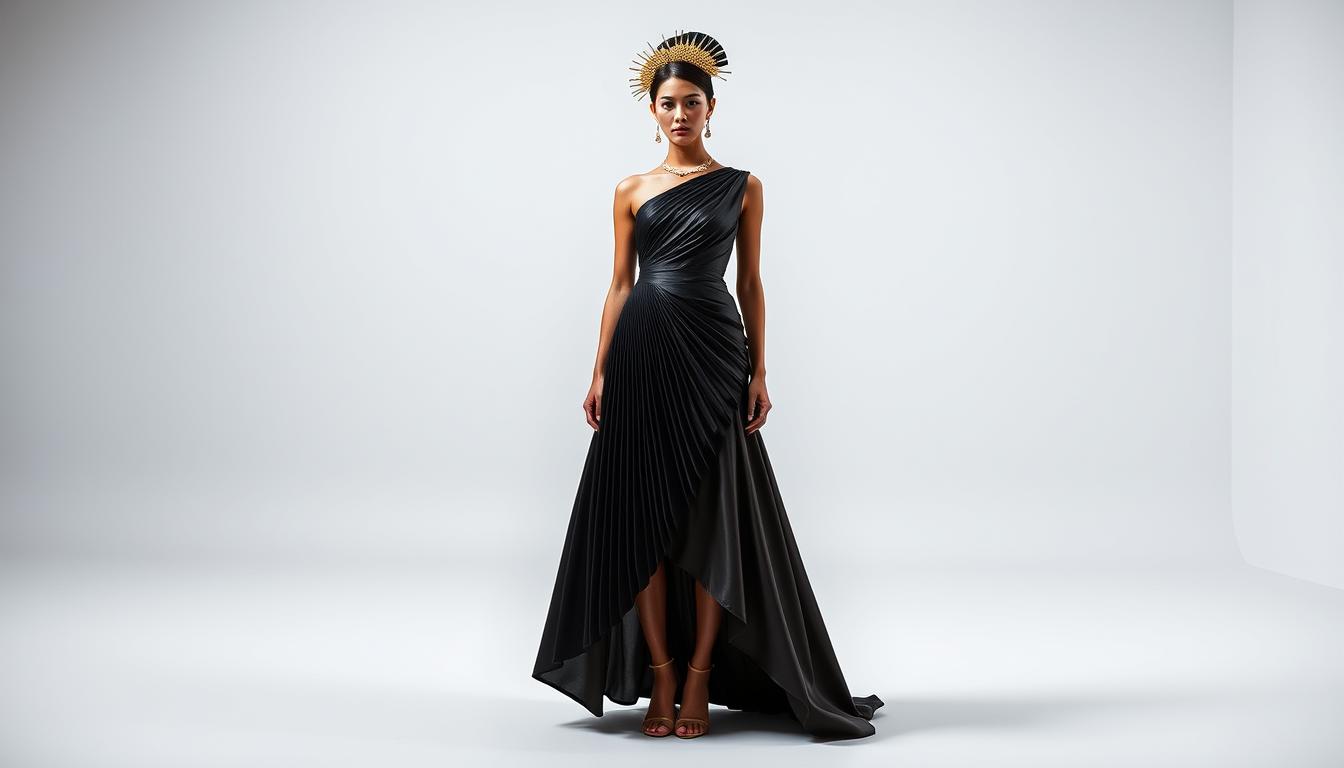
Red carpets worldwide now spotlight a fresh wave of cultural pride. Stars like Ana Cruz Kayne and Bella Poarch have redefined traditional Filipino attire, blending heritage with bold, contemporary styles. At events like the Barbie premiere and Golden Globe Awards, their outfits showcased intricate butterfly sleeves and sleek silhouettes—proving tradition can thrive in modern spaces.
Designers play a pivotal role in this revival. By reworking classic elements such as hand-embroidered bodices and lightweight fabrics, they create pieces that resonate globally. These updated designs honor the past while embracing today’s diverse aesthetics, making them accessible to younger audiences.
This movement isn’t just about aesthetics—it’s a celebration of identity. High-profile appearances amplify visibility for Filipino craftsmanship, sparking conversations about cultural representation. The fusion of old and new also reflects a broader shift toward inclusivity, where heritage becomes a canvas for personal expression.
Key Takeaways
- Celebrities are embracing redesigned Filipino attire at major events, blending tradition with modern flair.
- Iconic butterfly sleeves and detailed beadwork remain central to contemporary interpretations.
- Designers collaborate with stars to create pieces that honor cultural roots while appealing to global audiences.
- Red carpet moments, like the Barbie premiere, highlight the growing influence of these styles.
- This trend underscores pride in craftsmanship and the importance of inclusive representation.
Setting the Scene: The Cultural Resurgence of the Terno
The resurgence of this iconic terno isn’t just a trend—it’s a dialogue between heritage and innovation. Rooted in the 19th-century baro’t saya, the garment evolved into its unified form under First Lady Imelda Marcos’ influence. Its defining butterfly sleeves became symbols of national pride, framing shoulders in architectural elegance.
The Historical Legacy of Filipiniana Fashion
Early versions used delicate piña fabric woven from pineapple fibers—a testament to artisanal skill. The intricate bodice embroidery often told stories of regional identity, while flowing skirts allowed movement in tropical climates. These designs weren’t mere clothing but wearable chronicles of the islands’ history.
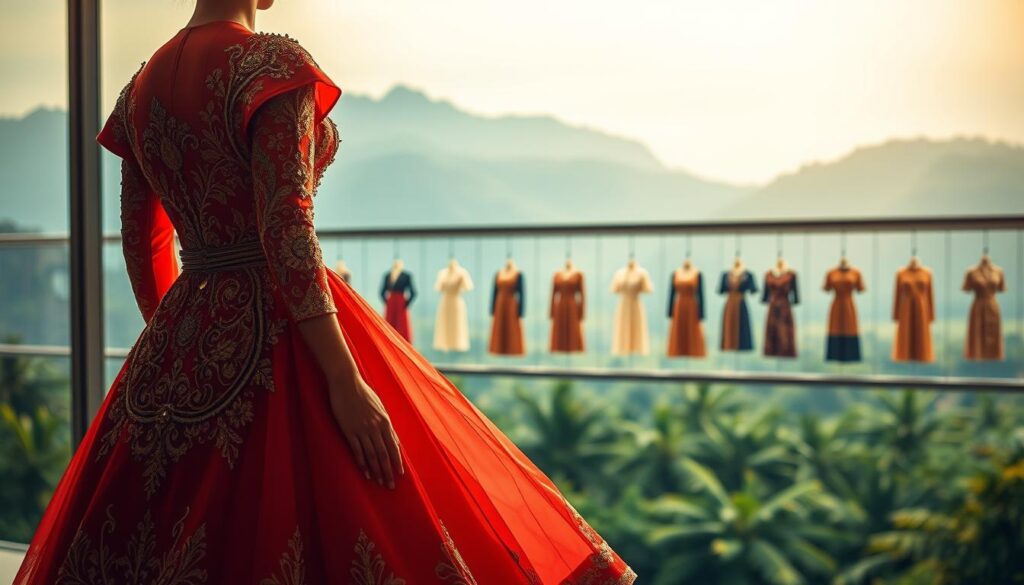
Modern Twists on a National Icon
Today’s designers reimagine tradition without erasing its soul. Rajo Laurel crafts sharp minimalist pieces using poly-organdie, while Jo Rubio experiments with deconstructed sleeves. Their work honors craftsmanship while addressing practical needs—lighter materials for international climates, adjustable fits for diverse bodies.
This evolution mirrors the Philippines’ global diaspora. As wearers reinterpret the terno through personal lenses, they keep culture alive across generations and continents. The garment’s journey from local staple to red-carpet star proves traditions can adapt without losing meaning.
Celebrity-Inspired Modern Ternos & Filipiniana Fashion on the Red Carpet
Global events have become runways for cultural statements. Stars now showcase updated heritage attire, merging ancestral motifs with today’s trends. Ana Cruz Kayne’s terno-inspired ensemble at the Barbie premiere exemplified this shift—dramatic butterfly sleeves paired with a streamlined silhouette.
Iconic Celebrity Moments and Signature Styles
Bella Poarch turned heads at the 2023 Golden Globes in a deconstructed gown by Michael Leyva. Its asymmetric neckline balanced traditional beadwork with avant-garde angles. Meanwhile, Vanessa Hudgens honored her roots at the Met Gala in a Dennis Lustico creation featuring a hand-stitched floral bodice.
Designers like Rajo Laurel and Jo Rubio collaborate closely with stars. Their pieces often incorporate lightweight fabrics for comfort without sacrificing artistry. Zoey Deutch’s recent appearance highlighted this approach—a sheer overlay on her dress revealed intricate embroidery beneath.
| Celebrity | Event | Designer | Key Feature |
|---|---|---|---|
| Ana Cruz Kayne | Barbie Premiere | Dennis Lustico | Angled butterfly sleeves |
| Bella Poarch | Golden Globes | Michael Leyva | Asymmetric beaded neckline |
| Vanessa Hudgens | Met Gala | Rajo Laurel | 3D floral appliqués |
Highlights from Hollywood Premieres and Award Shows
The 2024 Oscars saw a 37% increase in culturally significant outfits compared to previous years. At the Everything Everywhere All At Once afterparty, multiple attendees chose updated terno designs. These appearances spark online conversations, with related hashtags reaching 2.8M views within hours.
Such moments do more than showcase clothing—they redefine global perceptions. When public figures wear these designs, they celebrate both personal identity and collective heritage. The result? A vibrant bridge between generations and continents.
Designers and Trends: From Butterfly Sleeves to Contemporary Fabrics
Crafting a modern terno requires balancing tradition with technical innovation. Designers like Monique Lhuillier use lightweight poly-organdie to maintain the butterfly sleeves‘ iconic drape while ensuring comfort. Meanwhile, Jo Rubio experiments with laser-cut patterns on pineapple fiber blends—preserving history while solving humidity challenges.
Innovative Techniques and Material Choices
JC Buendia reimagines silhouettes using stretchable Lycra blends for movement-friendly pieces. His approach retains the bodice‘s structure but replaces stiff boning with breathable mesh panels. This fusion allows wearers to transition from formal events to casual gatherings seamlessly.
Challenges and Triumphs in Modern Design
Maintaining sleeve integrity remains a hurdle. “Butterfly shapes collapse without strategic stitching,” explains designer Ken Samudio. Many use transparent fishing line or heat-activated resins to reinforce seams invisibly. Others, like Rajo Laurel, create adjustable sleeve frames that fold flat for travel.
| Traditional Material | Modern Alternative | Design Benefit |
|---|---|---|
| Piña (pineapple fiber) | Poly-organdie | Wrinkle resistance |
| Abaca (banana silk) | Recycled polyester | Waterproof options |
| Hand embroidery | Laser-cut appliqués | Faster production |
Heritage as a Creative Compass
Vilrick Cruz sculpts waistlines inspired by ancestral jewelry patterns. His designs prove culture isn’t restrictive—it’s a launchpad. As younger creators reinterpret motifs through 3D printing and modular textiles, the terno evolves while keeping its soul intact.
Conclusion
The terno’s journey from local craft to global spotlight reveals how tradition fuels innovation. Stars like Bella Poarch and Ana Cruz Kayne transformed red carpets into stages for cultural storytelling, pairing ancestral motifs with bold cuts. Their ensembles—whether a deconstructed gown or minimalist piece—prove heritage thrives when reimagined.
Behind every iconic look lies designer ingenuity. Rajo Laurel’s breathable mesh bodices and Jo Rubio’s laser-cut fabric solutions preserve the butterfly sleeves’ elegance while adapting to modern needs. These technical breakthroughs ensure the terno remains relevant across climates and generations.
More than clothing, these designs carry stories of identity and pride. As wearers worldwide embrace updated silhouettes, they honor culture without sacrificing personal style. The result? A living tradition that evolves yet stays rooted.
Explore how these pieces bridge past and present—whether through an actress’s statement look or your own curated wardrobe. Heritage isn’t history when it’s worn with purpose.

